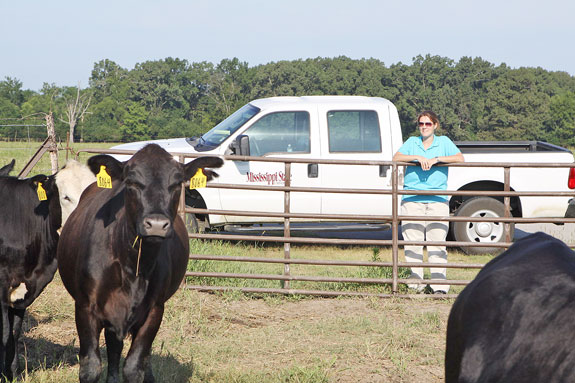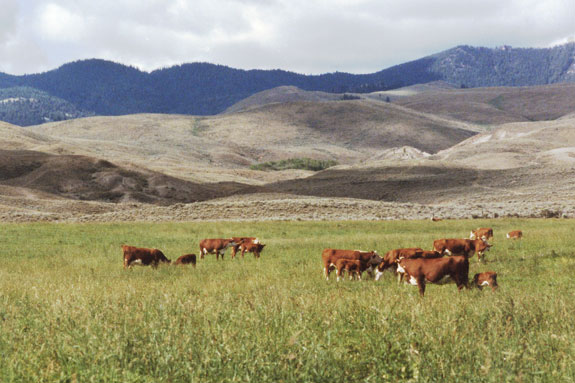Understanding grazing behavior can help stockmen optimize production when managing cattle on pastures.
Plant selection when grazing is partly instinctive and partly learned. Social factors also affect where and when cattle graze.
Holly T. Boland, an associate research and extension professor at the Mississippi Agricultural and Forestry Experiment Station’s Prairie Research Unit and Mississippi State University, has done grazing studies with cattle in Virginia Tech, in Mississippi and in collaboration with researchers at Louisiana State University.

Plant preferences
Boland’s work in Virginia looked at preferences between grasses and legumes, specifically grazing selection between tall fescue and alfalfa.
Earlier research in Great Britain, New Zealand and Australia looked at cattle preferences when grazing ryegrass and white clover.
“In most of those studies they found it didn’t really matter what proportion of those plants were in the pasture,” she said.
“There might not be much clover, for instance, and a lot more ryegrass, but the animals would consistently eat about 70 percent of their diet as legume and 30 percent as grass.”
Cattle sought out the legume to make up that proportion. The animals innately know they need adequate protein for the rumen to function optimally.
“Studies have also been done in a lab with artificial rumens and found that the efficiency of the microbes (responsible for breaking down fiber) was best at about 70 percent legumes. These animals know what they should eat for best digestion,” she explains.
Calves learn much of their behavior from their dams. This is why it’s difficult to get an orphan, bottle-fed calf to start eating forages at a young age – that calf has no role model to mimic. Calves learn about what they should or shouldn’t eat from their dams.
Earlier research noted how cattle preferences change as the day wears on, such as eating legumes in morning and grass in afternoon.
Boland says two theories explain this. One is the difference in carbohydrate levels in the grass, with more sweetness in the afternoon due to a longer period of photosynthesis and more time to store sugars.
A second thought is that cattle want something higher in fiber (the grass rather than the legume) late in the day to maintain more gut fill during the night. “Then they wouldn’t have to be up during the night grazing when they’d be more at risk for predation,” says Boland.

Grazing patterns
Being prey animals, and finding safety in the herd, cattle tend to stay together whether grazing or sleeping.
One lone animal off by itself grazing would be more at risk from predators. Cattle don’t graze much at night if it’s dark but will get up as a group sometimes and graze on a moonlit night.
In summer, cattle also change their grazing patterns and do more of their grazing in the very early morning, late evening or even at night rather than mid-day.
“They always have their biggest meals in the morning and in the late afternoon, before the heat of the day and before dark,” she said. “But they will get up earlier and graze later when it’s really hot.”
In northern climates with cold winters, cattle may not graze enough on cold days when daylight is short and nights are long.
On cold mornings, cows may not start grazing until they’ve had sunshine to help warm them up, and grazing time during daylight hours is short.
They are reluctant to leave their warm bed until the sun comes up and may stand in the sunshine a while before they go graze. In these instances, it pays to give them a little supplement early in the morning to get them started or they won’t graze enough during the day.
If there is plenty of good forage, cattle spend less time grazing than when feed is sparse (having to seek it out or take smaller bites when grass height is short) or when quality is poor.
If forage is too mature and coarse, and low in nutritional value, cattle must spend more time grazing to get the nutrients they need, but they may also have to spend a longer time chewing the cud to break down this coarser feed for further digestion.
At some point they may not be able to eat enough (and lose weight) because of the excessive amount of time necessary for chewing the cud, according to Boland.
“This is when they need more protein (supplement) to aid digestion and enable them to process the rough feed. The type of pasture will make a difference,” she said.
In winter or early spring, for instance, when there’s no new growth yet, they may need protein or good-quality hay to help them utilize that pasture.
“You don’t necessarily need a grain-based supplement. Good-quality alfalfa hay can provide the needed protein. You don’t want cattle to lose body condition just because they can’t eat enough of the poor-quality forage,” she explains.
The time of day for supplementation can make a difference in how much or when they graze. Boland did a project with LSU researchers that looked at supplementing in the morning, mid-day and afternoon.
“In that study, we found that, supplementing in the morning, those cattle grazed less total forage than the groups fed mid-day or in the afternoon.
I think this was because we were interrupting their morning meal,” she said. “Morning seems to be their biggest grazing period, since they are usually hungry after not eating during the night.”
Social behaviors
Cattle are social grazers and may not leave the bedground to graze until the lead cow does or go to water until she does.
“The dominant animals within a herd are generally the ones that decide where they all go and make the decisions for the rest. The stragglers don’t want to be left by themselves, so they go with the herd,” says Boland.
Cattle are also fairly adaptable, as when grazing management is changed. Under natural conditions they roam in groups over large areas, but this behavior is thwarted in small, intensively managed pastures such as MIG or mob grazing systems.
“These systems are more about optimum utilization of grass rather than letting the animals select the plants they eat,” she says.
Most rotational grazing systems have cattle eating plants at a certain stage of palatable regrowth so they will eat everything in the pasture – down to a certain plant height – and then move to the next pasture.
“You take away much of the ability of the animal to select what they want to eat. But from a management point of view, this gives a high level of utilization of pasture production,” she explains.
“If they have good pastures, cattle still get a good diet,” says Boland. And with some of the mob grazing systems, where cattle only stay in a piece of pasture for a few hours, they are eating only the tops of the plants (where most of the food value is, rather than the lower stems) and trampling the rest to create litter that boosts soil fertility.
“We do some rotational grazing here, but it’s not that intensive – longer intervals and the cattle can still select the plants they want,” she says. With continuous grazing, the cattle are staying season-long in the same pasture.
A drawback in that situation is that the favorite plants get grazed over and over and never get much chance to regrow, while others become so tall and coarse that the animals won’t eat them. ![]()
PHOTOS
TOP: Holly Boland’s study looked at what percentages of fescue and alfalfa were selected by cattle in their daily diet. Photo courtesy of Holly Boland.
MIDDLE: Holly Boland with some of the cattle in her grazing studies. Photo courtesy of Sammy Blossom.
BOTTOM: Cattle generally graze together in groups in natural conditions as they roam large areas. Photo courtesy of Heather Smith Thomas.








